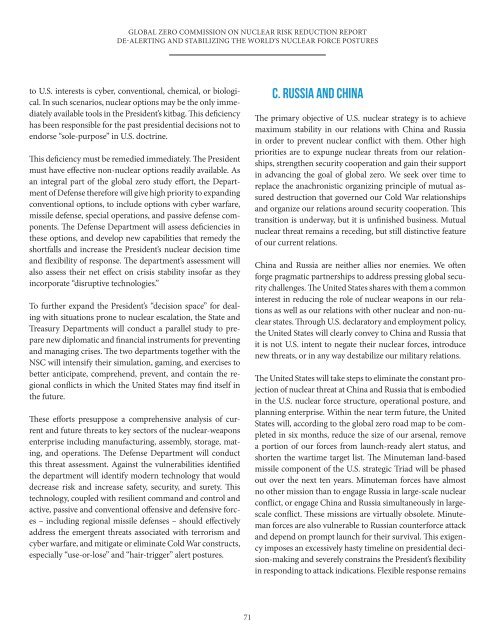global_zero_commission_on_nuclear_risk_reduction_report
global_zero_commission_on_nuclear_risk_reduction_report
global_zero_commission_on_nuclear_risk_reduction_report
Create successful ePaper yourself
Turn your PDF publications into a flip-book with our unique Google optimized e-Paper software.
GLOBAL ZERO COMMISSION ON NUCLEAR RISK REDUCTION REPORTDE-ALERTING AND STABILIZING THE WORLD’S NUCLEAR FORCE POSTURESto U.S. interests is cyber, c<strong>on</strong>venti<strong>on</strong>al, chemical, or biological.In such scenarios, <strong>nuclear</strong> opti<strong>on</strong>s may be the <strong>on</strong>ly immediatelyavailable tools in the President’s kitbag. This deficiencyhas been resp<strong>on</strong>sible for the past presidential decisi<strong>on</strong>s not toendorse “sole-purpose” in U.S. doctrine.This deficiency must be remedied immediately. The Presidentmust have effective n<strong>on</strong>-<strong>nuclear</strong> opti<strong>on</strong>s readily available. Asan integral part of the <str<strong>on</strong>g>global</str<strong>on</strong>g> <str<strong>on</strong>g>zero</str<strong>on</strong>g> study effort, the Departmentof Defense therefore will give high priority to expandingc<strong>on</strong>venti<strong>on</strong>al opti<strong>on</strong>s, to include opti<strong>on</strong>s with cyber warfare,missile defense, special operati<strong>on</strong>s, and passive defense comp<strong>on</strong>ents.The Defense Department will assess deficiencies inthese opti<strong>on</strong>s, and develop new capabilities that remedy theshortfalls and increase the President’s <strong>nuclear</strong> decisi<strong>on</strong> timeand flexibility of resp<strong>on</strong>se. The department’s assessment willalso assess their net effect <strong>on</strong> crisis stability insofar as theyincorporate “disruptive technologies.”To further expand the President’s “decisi<strong>on</strong> space” for dealingwith situati<strong>on</strong>s pr<strong>on</strong>e to <strong>nuclear</strong> escalati<strong>on</strong>, the State andTreasury Departments will c<strong>on</strong>duct a parallel study to preparenew diplomatic and financial instruments for preventingand managing crises. The two departments together with theNSC will intensify their simulati<strong>on</strong>, gaming, and exercises tobetter anticipate, comprehend, prevent, and c<strong>on</strong>tain the regi<strong>on</strong>alc<strong>on</strong>flicts in which the United States may find itself inthe future.These efforts presuppose a comprehensive analysis of currentand future threats to key sectors of the <strong>nuclear</strong>-weap<strong>on</strong>senterprise including manufacturing, assembly, storage, mating,and operati<strong>on</strong>s. The Defense Department will c<strong>on</strong>ductthis threat assessment. Against the vulnerabilities identifiedthe department will identify modern technology that woulddecrease <strong>risk</strong> and increase safety, security, and surety. Thistechnology, coupled with resilient command and c<strong>on</strong>trol andactive, passive and c<strong>on</strong>venti<strong>on</strong>al offensive and defensive forces– including regi<strong>on</strong>al missile defenses – should effectivelyaddress the emergent threats associated with terrorism andcyber warfare, and mitigate or eliminate Cold War c<strong>on</strong>structs,especially “use-or-lose” and “hair-trigger” alert postures.C. RUSSIA AND CHINAThe primary objective of U.S. <strong>nuclear</strong> strategy is to achievemaximum stability in our relati<strong>on</strong>s with China and Russiain order to prevent <strong>nuclear</strong> c<strong>on</strong>flict with them. Other highpriorities are to expunge <strong>nuclear</strong> threats from our relati<strong>on</strong>ships,strengthen security cooperati<strong>on</strong> and gain their supportin advancing the goal of <str<strong>on</strong>g>global</str<strong>on</strong>g> <str<strong>on</strong>g>zero</str<strong>on</strong>g>. We seek over time toreplace the anachr<strong>on</strong>istic organizing principle of mutual assureddestructi<strong>on</strong> that governed our Cold War relati<strong>on</strong>shipsand organize our relati<strong>on</strong>s around security cooperati<strong>on</strong>. Thistransiti<strong>on</strong> is underway, but it is unfinished business. Mutual<strong>nuclear</strong> threat remains a receding, but still distinctive featureof our current relati<strong>on</strong>s.China and Russia are neither allies nor enemies. We oftenforge pragmatic partnerships to address pressing <str<strong>on</strong>g>global</str<strong>on</strong>g> securitychallenges. The United States shares with them a comm<strong>on</strong>interest in reducing the role of <strong>nuclear</strong> weap<strong>on</strong>s in our relati<strong>on</strong>sas well as our relati<strong>on</strong>s with other <strong>nuclear</strong> and n<strong>on</strong>-<strong>nuclear</strong>states. Through U.S. declaratory and employment policy,the United States will clearly c<strong>on</strong>vey to China and Russia thatit is not U.S. intent to negate their <strong>nuclear</strong> forces, introducenew threats, or in any way destabilize our military relati<strong>on</strong>s.The United States will take steps to eliminate the c<strong>on</strong>stant projecti<strong>on</strong>of <strong>nuclear</strong> threat at China and Russia that is embodiedin the U.S. <strong>nuclear</strong> force structure, operati<strong>on</strong>al posture, andplanning enterprise. Within the near term future, the UnitedStates will, according to the <str<strong>on</strong>g>global</str<strong>on</strong>g> <str<strong>on</strong>g>zero</str<strong>on</strong>g> road map to be completedin six m<strong>on</strong>ths, reduce the size of our arsenal, removea porti<strong>on</strong> of our forces from launch-ready alert status, andshorten the wartime target list. The Minuteman land-basedmissile comp<strong>on</strong>ent of the U.S. strategic Triad will be phasedout over the next ten years. Minuteman forces have almostno other missi<strong>on</strong> than to engage Russia in large-scale <strong>nuclear</strong>c<strong>on</strong>flict, or engage China and Russia simultaneously in largescalec<strong>on</strong>flict. These missi<strong>on</strong>s are virtually obsolete. Minutemanforces are also vulnerable to Russian counterforce attackand depend <strong>on</strong> prompt launch for their survival. This exigencyimposes an excessively hasty timeline <strong>on</strong> presidential decisi<strong>on</strong>-makingand severely c<strong>on</strong>strains the President’s flexibilityin resp<strong>on</strong>ding to attack indicati<strong>on</strong>s. Flexible resp<strong>on</strong>se remains71


